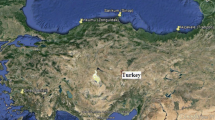Abstract
Grain-shape studies were made with traditional and scanning electron microscopic methods on sand samples from Quaternary geological profiles in the Nyírség area in North Hungary. It was found that the sand layers had originally undergone fluvial transport, then suffered aeolian reworking. However, the latter impact did not completely eliminate the features brought about by fluvial transportation. The scanning electron microscopic examinations enabled us to distinguish between grain types originating in the host rock, those displaying diagenetic impacts, grains transported in the fluvial or aeolian way, and those showing chemical effects or polygonal cracks due to insolation. The impacts began with the diagenetic effect, and continued with fluvial and/or aeolian transportation. The chemical effect presumably took place partly during transportation, but mainly following it. The most reliable results for the determination of the sedimentary environment can be obtained through the joint application of the traditional and the scanning electron microscopic methods.
Similar content being viewed by others
References
Baker, H. W.: Environmental sensitivity of submicroscopic surface textures on quartz sand grains: a statistical evaluation. Jour. Sed. Petr. 46, 871–880 (1976)
Blackwellder, P. L.; Pilkey, O. H.: Electron microscopy of quartz grain surface textures: The U. S. Eastern Altantic continental margin. Jour. Sed. Petr. 42, 520–526 (1972)
Borsy, Z.: Görgetettségi vizsgálatok a magyarországi futóhomokon (Grain shape examination on Hungarian blown sand. In Hung. Eng. summ.). Földr. Ért. 14, 116 (1965)
Borsy, Z.: A magyarországi futóhomok területek felszínfejlödése (Surface development of blow sand area of Hungary. In Hung. Eng. summ.). Földr. Közl. 25(1–3). 13–16 (1977)
Borsy, Z.; Félszerfalvi, J.; Lóki, J.: A jánoshalmi MÁFI alapfúrás homoküledékeinek elektronmikroszkópos vizsgálata. (Electron microscopic examination of sand sediments in the drilling of Jánoshalma, Hungary. In Hung. Eng. sum.) Acta Geog. Debr. 20(143), 35–50 (1982)
Bull, P. A.: Environmental reconstruction by electron microscopy. Prog. Phys. Geog. 5, 386–397 (1981)
Cailleux, A.: Morphoskopische Analyse der Geschiebe und Sandkörner und ihre Bedeutung für die Palaoklimatologie. Geol. Rundschau 40, 11–19 (1952)
Cailleux, A.: Application á la geographie des methodes d'étude des sables et galets. Curso de Altos Estudos Geograficos 2. Rio de Janeiro, Brasil, pp. 15–149 (1961)
Carver, R. E. (ed.): Procedures in sedimentary petrology. Wiley Interscience, New York 1971.
Culver, S. J.; Bull, P. A.; Campbell, S.; Shakesby, R.; Whalley, W.B.: Environmental discrimination based on quartz grain surface textures: a statistical investigation. Sedimentology 30, 129–136 (1983)
Dávid, P.: A Duna-Tisza közi futóhomok koptatottsága (Grain shape examination on sand of Duna-Tisza, Hungary) Pályamunka, Szeged Föld. Int. (Kézirat) 1–61 (1955)
Fishawi, N. M.; Molnár, B.: Distinction of the Nile Delta coastal environments by electron microscopy: A statistical evaluation. Acta Miner., Petr. 26(2), 247–259 (1984)
Friedman, G. M.; Ali, S. A.; Krinsley, D. H.: Dissolution of quartz accompanying carbonate precipitation and cementation in reefs: example from the Red Sea. Journ. Sed. Petr. 46, 970–973 (1976)
Higgs, R.: Quartz grain surface features of Mesozoic-Cainozoic sands from the Labrador and western Greenland Continental margins. Journ. Sed. Petr. 49, 599–610 (1979)
Ingersoll, R. V.: Surface textures of first cycle quartz sand grains. Journ. Sed. Petr. 44, 151–157 (1974)
Krinsley, D. H.; Takahashi, T.: The surface textures of sand grains, an application of electron microscopy. Science 138, 923–925 (1962)
Krinsley, D. H.; Donahue, J.: Environmental interpretation of sand grain surface textures by electron microscopy. Geol. Soc. Am. Bull. 79, 743–748 (1968)
Krinsley, D. H.; Margolis, S.: A study of quartz sand grain surface textures with the scanning electron microscope. New York Acad. Sci. Trans. 31, 457–477 (1969)
Krinsley, D. H.; Margolis, S.: Grain surface textures. pp. 151–180. In: Carver, R.E. (ed.), Procedures in sedimentary petrology. Wiley Interscience, New York 1971.
Krinsley, D. H.; Doornkamp, J. C.: Atlas of quartz sand surface textures. Cambridge Univ. Press, London 1973.
Krinsley, D. H.; Biscaye, P. E.; Turekian, K.: Argentine basin sediment source as indicated by quartz surface textures. Journ. Sed. Petr. 43, 251–257 (1973)
Kuenen, Ph. H.; Perdok, W. G.: Experimental abrasion of quartz grains. Journ. of Geol. 70, 648–658 (1962)
Lucci, F. R.: Shrinkage cracks on frosted surface of desert sand grains. Geol. News, 9, 18–20 (1971)
Manker, J. P.; Ponder, R. D.: Quartz grain surface features from alluvial environments of northern Georgia. Journ. Sed. Petr. 48, 1227–1232 (1978)
Margolis, S. V.: Electron microscopy of chemical solution and mechanical abrasion features on quartz sand grains. Sed. Geol. 7, 243–256 (1968)
Margolis, S. V.; Kennett, J. P.: Cenozoic paleoglacial history of Antarctica recorded in Subantarctic deep-sea cores. Am. Journ. Sci. 221, 1–36 (1971)
Miháltz, I.; Ungár, T.: Folyóvízi és szélfútja homok megkülönböztetése (Distinction between fluviatile and blow sand. In Hung. Eng. summ.) Földt. Közl. 84 (1–2), 8–17 (1954)
Molnár, B.: A Duna-Tisza közi eolikus rétegek felszíni és felszín alatti kiterjedése (Surface and subsurface development of eolian beds on the area of Duna-Tisza, Hungary. In Hung. Eng. summ.). Földt. Közl. 91(3), 303–315 (1961)
Pettijohn, F. J.: Sedimentary rocks. Harper Brothers, New York 1957.
Russel, R. D.; Taylor, R.E.: Roundness and shape of Missisippi river sands. Journ. Geol. 45(1), 225–267 (1973)
Author information
Authors and Affiliations
Rights and permissions
About this article
Cite this article
Molnár, B., Fényes, J. & Kuti, L. Application and comparison of the results of optical and scanning electron microscopic methods for grain-shape examination on Quaternary formations. GeoJournal 36, 157–168 (1995). https://doi.org/10.1007/BF00813162
Issue Date:
DOI: https://doi.org/10.1007/BF00813162




